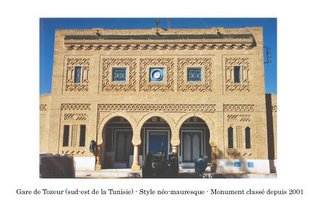Colonial Architecture in Tunisia




Shiraz Misbah, a friend who just defended a thesis on Tunisian Colonial Architecture in Paris IV, sent me these pics with their labels. The subject was negledted for a long time even though the city of Tunis as built by the French is in in its great part a witness of the legacy of that period. I think colonial architecture was a major phase in the history of architecture in Tunisia because it left a huge impact on our the local archietctural mind for a long time afterwards. The styles of these buildings (eclectic, art deco, neo-moricos...) were in fashion all around the Islamic world by the end of the 19th and early 20th centuries (Morocco, Egypt, Turkey...): the what became known as the architectural colonialist mind had found its way to the "idegenous" mind and was trying to construct a certain "Medietrranean" identity that recognizes a contsructed image of the "past" (eclectic and no-moriscos) and at the same time it was trying to use contemporary styles in the west (art deco)...
The question of colonial architecture is somehow related to the very hot debate now about the "poisitve legacy" of the French occupation of North Africa... Since the French political class still thinks that the French occupation was "positive" (mainly the right but even the left does not seem to really care about the issue if it was not highly contested by the North Africans living in France especially after the last riots)... the question of how to treat colonial architecture, I think, becomes highly politicized even when we don't want it to be so... It seems to me that a key point when treating the subject should emphasize the fatc that it has to be clear that most of colonial architecture is made by French architects assigned by the repressive power of the occupation... On the other hand because it was made in Tunisia and it had a major impact on later Tunisian architects it becomes part of our contemporary architecture, regardless if we like or not... The problem, therefore, is complicated and it has two contradictory parts: even though colonial architecture was not possible without being imposed, by force we should not forget, on the Tunisian land and even though (and this its major characteristic) it was made by architect who were never trained in Tunisia and they were simply brought by the French (not all of them were French there were some Italians, Maltese, Austrians...) the colonial styles lived long and affected the architectural and visual tastes of Tunisian architects; therefore it became part of Tunisian architectural mind... and we cannot simply deny that....
Shiraz wrote an article lately in the last issue of Qantara
Les influences crois�es de l'architecture coloniale
Les m�dinas de Tunisie ont �t� marqu�s, � travers les si�cles du sceau d'une m�me configuration architecturale et d�corative avec, de temps � autre, l'�mergence d'�l�ments nouveaux. [...]Des �l�ments typologiques nouveauxCette longue gestation int�grant de nouveaux �l�ments occidentaux s�accentue avec le d�but du Protectorat fran�ais en 1881 et la naissance de villes coloniales r�pondant � un principe d�urbanisation r�gulier. Les villes tunisiennes commencent ainsi � conna�tre une longue vague constructive faisant appel au savoir-faire d�intervenants (architectes, entrepreneurs, ma�ons, artisans) de diverses nationalit�s, r�v�lant un important enrichissement artistique et l�apparition de nouveaux styles architecturaux et d�coratifs. C�est donc dans un contexte moderniste et avec l�arriv�e des Fran�ais qu�un paysage urbain inhabituel commence � se profiler et que des �l�ments typologiques nouveaux font leur apparition (fa�ades sur rue richement d�cor�es, v�randas, balcons, etc.). [...]L�implantation d�une architecture ext�rioris�eLes nouveaux �difices d��poque coloniale introduisent une �uvre artistique �trang�re � la Tunisie musulmane qui se traduit par l�implantation d�une architecture ext�rioris�e, aux fa�ades monumentales et richement d�cor�es. Les constructions s�assemblent dans un m�lange de styles caract�ristique du pays tout en s�enrichissant les unes des autres et en cr�ant des allures urbaines diverses aux contrastes frappants. [...]Une architecture en p�rilCes constructions d��poque coloniale pr�sentent actuellement des signes inqui�tants de vieillissement et posent de graves probl�mes de conservation. L�indiff�rence, la n�gligence, le manque d�entretien et de moyens financiers, les transformations incontr�l�es ainsi qu�une forte sp�culation fonci�re d�figurent de mani�re irr�m�diable le paysage urbain tunisien et participent � la disparition lente d�un patrimoine m�connu, pourtant exceptionnel. [...]R�cemment, l�id�e s�est impos�e de la mise en valeur et de la sauvegarde des b�timents coloniaux d�importance majeure. La situation semble donc �voluer puisque, d�sormais, les anciennes aires europ�ennes sont consid�r�es par l��tat comme faisant partie du patrimoine national. Diff�rentes formes d�intervention sont ainsi �tablies pour leur pr�servation. [...]Aujourd�hui, nombre de traces de l��poque coloniale ont disparu, tandis que d�autres s�estompent lentement pour laisser place � de nouvelles formes architecturales r�pondant � des tendances modernistes et que de nouveaux d�cors remplacent les fa�ades et les devantures des �difices coloniaux, devenues d�su�tes. Ces choix se traduisent par une uniformisation du paysage urbain des villes tunisiennes et par la propagation d�un � style international � monotone et inadapt� au climat.
�Chiraz Mosbah est doctorante � Paris IV-Sorbonne et assistante � l�Institut sup�rieur des Beaux-Arts de Sousse.


1 Comments:
I don't have any myself... as I said these were sent to me by a friend who wrote on the subject: Shiraz Mosbah...
Post a Comment
<< Home